|
Many marketers would be astounded that I have even asked the question. In today’s modern world and circumstances, how can anyone not have a website? Surely a business can’t survive without a website to attract, inform and convert people into paying customers? Do I need a website for my business?Before the COVID-19 pandemic, I continued to come across businesses who didn’t have a website - yet they had been in business for a number of years, rather than weeks. These businesses had survived on other tools and techniques. The independent cafe that attracted customers through Google Search (using Google My Business), a Facebook page and word of mouth, the coach that built his reputation from a heavy investment in networking and referrals and the construction company that partnered with key suppliers who would ‘throw work their way’ on a regular basis and they did very little marketing at all. Survive or thrive? From the above examples, it’s possible to run a business without a website (Shock! Horror! Really?). These companies are clearly the exception and the number of business that can do this over the long-term has to be dropping*. While some businesses without a website have been able to continue to thrive and grow, I believe that most are simply surviving. Without factoring in COVID-19, If you asked them how business is going, they would respond “it’s ok. Not brilliant but you know. We are still going and earning enough”. “If you always do what you have always done, you will always get what you have always gotten” - unknown … or maybe not? If a business is happy surviving and has no ambition to grow or take their business ‘to the next level’ then it might be possible to survive by doing very little marketing or without a website, but this is a very risky strategy (or should I say a very risk not-a-strategy?). As much as I love the above quote, there’s an equally powerful quote for businesses that I like: "If you don't drive your business, you will be driven out of business" - Forbes Standing still on activities could actually mean going backwards. Not doing marketing activities or not having a website doesn’t mean your business will continue to generate business at its current level. It means you could lose business, sales will most likely decline and survival is less likely. I remember meeting a business owner, who provided trade services, at a networking event a few years ago. He said that, after around 10 years in business, he was networking for the first time and having to look at his marketing. They had relied for many years on word of mouth, but business was, in his words ‘beginning to dry up’. The benefits of a website for your businessWe won’t go through all of the benefits of a website here, but having a website means you can be found by more potential customers through channels such as Google Search. Potential customers are more likely to trust your brand and therefore use your services, and you can also create more marketing activities that generate a higher conversion rate. Examples of the latter include a simple landing page with a special offer or using Facebook Pixel code to drive down costs and better target your audience when running an Ad.
Summary You probably knew the answer to this already but, if you are serious about staying in business or growing it, then a website should be at the heart of any sales and marketing activity. Yes, people buy from people and referrals are a powerful form of marketing, but this has its limits - especially over the long term. If you are still in ANY doubt then do a quick calculation - how many customers do I need to generate to pay for a new or an updated site? For many businesses, an effective website will help attract a much larger number of paying customers. It’s almost, if not completely, a no-brainer. If you would like to find out more about effective websites and pricing, visit the Think Twice Marketing web services landing page. *I don’t have stats on this but I’m guessing it’s a pretty good gut feeling I have.
0 Comments
I have just finished reading ‘The Subtle Art of Not Giving A F*ck’ by Mark Manson (which if you would like an alternative perspective on life, I recommend reading). In the book, Mark talks about the Picasso napkin story which was new to me. If you haven’t heard it, the story goes something like this…
Picasso used to draw or doodle on his napkins when at a cafe and one day, he was asked by a woman if she could have the napkin to keep. She offered to pay whatever the napkin with his drawing was worth, to which Picasso responded that it would be $10,000. Slightly taken aback by the high valuation, the woman pointed out that it had only taken 30 seconds to create the artwork. Picasso promptly folded the napkin away into his pocket and responded ‘no, it has taken me 40 years to do that’. Depending on what website you visit the story varies slightly, and whether it was dollars, pounds or another currency, it was a considerable amount of money. There is, however, a good argument for not basing the price on how long the drawing took. When it comes to selling your services, do you quote an hourly rate depending on how long it takes to do a task? Do you price your products on the value to the customer? Or how many years of experience it has taken to learn the skills you have acquired so that you can deliver what you do… and so quickly? When talking to customers, and in my book Psychology in Marketing and Sales, I discuss different ways to price products to get the right results. A web designer, for example, might be able to create a website in one day and charge a daily rate - but if the customer does it themself, it might take days or even weeks. Added to this, a DIY website might not look as good, It might not function as well and it will most likely not convert web visitors into paying customers as effectively (resulting in lost sales in the long term). Similarly, a training instructor, coach, consultant or security business (just to name a few specialities!) can make a huge difference to anyone’s life or business, but only because of the skills they have developed over the years. And the prices they charge should reflect this. It’s true that you need to consider other factors when setting pricing such as what the competition is doing, how much competition there is and who your target audience is, but creating pricing based on ‘cost plus margin’ or an hourly rate could mean you are losing out considerable amounts of money. Sometimes it can take years of practice and experience in order to be able to continually create masterpieces in a very short time. That experience has a value. What’s your napkin worth, and what are you charging for it?
The number three is a magical number which if used properly in your marketing, can help get better results. I was trailing through my archived emails the other day when I came across an email talking about how remembering numbers is easiest when they are grouped into sets of three, and it got me thinking. How can this apply to marketing and sales?
Using the concept of grouping things into 3 means that you can do the following:
The way that the power of three works is simple (I could say I will explain it in 3 simple steps but on this occasion, I won’t). On its own, a single number, price or product seems ‘lonely’. It’s not comprehensive and there’s nothing to compare. The human mind can absorb a lot more information than that so lets at least double it… Two is good, but it could be better. If I ask you to remember a set of numbers, let’s say 702393, you could remember them individually as six separate numbers. You could remember them in groups of two, such as 70, 23, 93 or in groups of three such as 702, 393. You are more likely to remember them - and longer groups of numbers, in groups of three. In his book, How to Write Short, author Roy Peter Clark talks about how using the rule of 3 can be more entertaining and satisfying as well as being more effective. Before we apply this to marketing, let’s consider some real-world examples of how three is being used: Boris Johnson, the UK Prime Minister, was involved in using a simple 3 worded slogan during the EU referendum campaign that was simple and easy to understand: Take Back Control. He then became Prime Minister and won a general election with the three worded slogan ‘Get Brexit Done’ which almost seemed like his answer to everything… but it worked. In 2020 during the COVID-19 outbreak, he also made the message clear ‘stay home, protect the NHS, save lives’. Ok, so the first and last part are only 2 words, but the slogan is split into 3 sections that are easy to understand, memorable and made sense. Staying at home helped protect the NHS and helps to save lives. The power of 3 can be covering 3 words in a slogan or three individual concepts. Martin Luther King Jr., the civil rights activist, often used the power of 3 with lines such as “insult, injustice and exploitation” in one of his speeches* followed by “justice, goodwill, and brotherhood.”. Listing 5, 6 or even 10 things would have been harder to remember and would have diluted the message. Listing three things also makes the presenter seem more knowledgeable. Julius Caesar said “I came, I saw, I conquered”, Winston Churchill once said “Blood, sweat and tears” while the American Declaration of Independence says “Life, Liberty and the pursuit of happiness”. The power of three is not new, but it’s often forgotten when trying to make marketing more effective. Using it in your marketing In my book, Psychology in Marketing and Sales, I talk about Decoy Pricing which involves offering a third pricing option. This third option increases sales conversions and also results in customers opting for higher-priced products or services. This works for various reasons, one of which is that it takes the mind away from comparing lower-priced products, or not buying at all. In your marketing communication you can also use the power of 3 as follows:
Here are some examples to consider: An accountant might highlight they offer ways to save on tax, avoid fines and grow your business as the main benefits. A web designer might increase the value of a service by offering a 3 in 1 package: web design, blogging and social media for one single price. A software company might communicate that their product can be set up in 3, easy to follow steps. A fashion designer might use a slogan such as ‘look great, feel amazing, be different’ Whether you use 3 or another number in your marketing, it’s important to keep messages simple and easy to understand - while making your product attractive. If you would like help defining your marketing messaging and communicating to your customers then get in touch today. *His speech “Non-Violence and Racial Justice”
Updated 3 Nov 2021
What should you write about in a blog post?
Over the years, I’ve heard many people raise two issues when it comes to writing blog posts. Firstly, they don’t have the the time to write regular blog posts and secondly, they don’t know what to write about. Although in reality writing a blog post every month should only take a couple of hours every month, I’m not going to address the first issue in this article.
In answer to the quetions "what should I write about in a blog post", coming up with relevant and useful content can actually be easier than you think and once you get into your creative flow you’ll discover it’s actually a lot easier than you initially thought. Blog content ideas
I've been writing blog posts for over 10 years and from experience, I've never seen anyone sit down with a blank piece of paper and immediately know what they will write about and what the content storry will be.
The best approach to writing blog posts is to brainstorm - or write down a list of possible topics you would like to cover. Pick one of those topics and have a think about how you will structure your article. Before that, there's usually some initial resistance in our mindset that stops us from getting started.
The initial resistance
The first reaction by the human mind to the idea of writing a blog is ‘I can’t do that. I have no idea what to write about and where would I start?’ - but it’s important to make a start and that should be with writing down or brainstorming a list of ideas and topics. A few years ago, I did a training session for a marketing design company. They knew how to create amazing artwork and graphics for their customers but their team wanted to expand their knowledge on topics such as social media and how to create content on various social media and blogging platforms. After suggesting how often they should be posting content, the initial response from the team leader was ‘no, we won’t be posting that often. We don’t have the time to come up with ideas on a regular basis’ but half an hour later, they had a spreadsheet with a list of over twenty different topics they could use. How had this happened? After the initial ‘we can’t do that’ response, I suggested we spend 30 minutes discussing how to come up with ideas. we explored what sort of content could be covered and the conversation went something like this… Me: When you talk to your clients over the phone or face to face, what sort of advice do you give them? Give me a quick example. Team member one: Well, we might suggest that all artwork has their logo on to raise brand awareness and that the colours they use on their website, social media and other marketing materials are consistent and in line with their brand. Team member two: And that the logo should be crisp and easy to identify. We get customers from time to time who have used a blurred logo or their logo is so small you can’t read anything on it. Me: Great, you’ve just given me three or four top tips that you can use to create three or four separate social media posts and possibly a blog post with tips for creating professional branding. At this point, we listed a few more tips before I asked why someone should use them rather than do it themselves or outsource to a generic digital marketing agency. The arguments in favour included their expertise and knowledge of what designs and type of designs work best in marketing. This then became the basis for another blog post on how to choose the right company to help you with your branding. By now you get the idea. If you are a florist, what helpful tips do you give your customers that you can put into a blog post? Maybe this includes frequently asked questions such as ‘which flowers are best for this time of the year’ as well as tips such as how stems should be cut at an angle (I learned this from a customer who is a florist!) or what plant food to use. If you are a bookkeeper, what deadlines should your customers be aware of that you could turn into a blog post? What tips for managing expenses and receipts would you give? Should they use Excel or an online accounting package to track invoices and expenses? If you are a personal fitness trainer or health coach, what eating, sleeping and exercise tips could you give? Could you write about the importance of getting into a regular routine and creating healthy habits? And what are the benefits of using a personal trainer compared to trying to get fit on their own without personal guidance? I’m not a personal fitness trainer, florist or bookkeeper but there are plenty of ideas in this blog post to get you started - and once you get into the flow, you will find that more ideas come up more easily. By the end of my training session, the design agency had agreed to create a shared spreadsheet and team members could freely add suggested topics, tips and upcoming events that would be worth considering. The team leader would then review the spreadsheet and decide what content would be used and how it would be used. This would also include seasonal events throughout the year that were relevant. You might not have a team of marketers to share your thoughts and to give you ideas but you can always use colleagues and even friends and family for ideas. Sometimes having a different perspective can inspire you with new and better ideas for blog posts! By the way, if you are wondering how long a blog post should be then check out another of our blog posts titled How long should a blog post be? I don’t want to give away too much information I’ve heard the argument, especially with business offering services, that they don’t want to give away too much advice that they would otherwise provide as part of their service and make money from. I understand this argument but think of the approach differently. You should provide enough information that demonstrates that you know what you are talking about, that adds value to your potential customer and that leaves them saying ‘These are great tips and you clearly know what you are doing. I can’t do this myself so I need your help’. A business coach, for example, can offer great tips but always highlight how business owners that have a coach achieve greater results because they are more accountable or have someone to ‘bounce ideas off’ (or whatever benefits you as a coach see customers get from using your services rather than doing it themselves). This approach also applies to other types of businesses such as home DIY, gardening or even food manufacturing. You might provide some tips for baking their own cakes or painting their bedroom but many people still want you to do it for them - whether that’s to save them time or make sure the task or product is perfect! Other content ideas So far, we have mostly talked about tips and blog posts around why customers can benefit from your services, but there are other topics to talk about. You could also post about what's going on in your company. This helps to give a personal element to your business that people can associate with - but I don't recommend doing this too often. Whilst it adds a touch of personality and familiarity with the company, it tends to be of less value to a wider audience, especially if almost every post is ‘look at what we are doing’ rather than ‘here’s a post to help YOU!’ Here's a list of possible things that you can write a blog post about:
Let’s give some examples of what blog titles might look like based on the above list:
You might not agree initially, but whatever your business, there are plenty of things to write about. If you're really struggling to come up with ideas then take a look at your competitor's blog posts to see if you can write about similar topics. It’s important to avoid plagiarism but I’m fairly sure that whatever you write about, some elements of it will have been covered somewhere in the world. That doesn’t mean you shouldn’t cover that topic. People want to hear from you, whether that’s your thoughts or what you are doing locally or with your customers, specific to the topic you are writing about. A great source for posts such as top tips can come from questions that you get asked frequently. This helps with creating ideas and also shows that you understand the concerns - and thoughts - of your customers. Admittedly, it’s not always easy to come up with content but it’s easier than you might initially think. You are sure to come up with some great ideas to write about! If you would like to find out more about writing blog posts for your business, grab a copy of my book Blogging for business, or get in touch. We would be happy to write some great blog posts for you! When creating content for social media, it’s important to understand your objectives and the purpose of a post and a key objective for many posts should be to drive people to your website to take action. Unfortunately, there are many challenges such as:
There are many apps that you can use to get better results from what you post. In this blog post, I address the 3 issues mentioned above with some great apps worth considering. Note: While some of these apps offer free features, costs may be involved. Create your own thumbnails While images can grab the attention of followers on Facebook, LinkedIn and Twitter, they can’t have a link attached to them like they can on a website. That’s why posts with thumbnails get more click-throughs than images. Frustratingly, it’s difficult to control what the thumbnail looks like and on Twitter, you might not get a thumbnail at all when you post a link. There are technical ways to manage this with your website but a much better solution is to use an app that controls what the thumbnail looks like. I use Switchy to create a custom thumbnail. It allows users to add the image, title and description for the thumbnail and you can also create a custom URL. Creating your own thumbnails means you can make them stand out better and use the wording you want to entice visitors to click through. Create Multiple Link Bios I have talked about this in a previous post. Social media platforms only allow one clickable URL in your bio but by using a tool such as Shorby or Link In Bio (from Later.com) you can offer your fans a menu of options such as a direct link to your latest blog post, a link to your YouTube channel and much more - including a simple link to your website as well. Using this option gives visitors more choice on platforms such as Twitter as well as increasing the number of clicks from your Instagram posts. Visit Think Twice Marketing on Instagram and click on our bio to see how it works. Alternatively, you can click this link here to see the menu immediately: https://shor.by/9XC1 Third-party re-targeting Sometimes it’s great to show relevant and valuable articles to your fans from other websites but doing so means that they will visit that website and not yours! That’s where tools such as snip.ly and JotURL can help. At Think Twice Marketing we use JotURL for our customers so that a pop-up call to action appears on the third party website, promoting our customer and driving visitors back to their site. Yes - you read that correctly - a call to action on a different site! Imagine that you sell finance support for investments and pensions. You see a great article about how best to invest in your pension. Using a tool such as snip.ly you can have a button with a message on the site they are visit saying ‘Contact us for a FREE pension review’ Here’s an example that we have used for our own business to promote my books: https://jo.my/marketingbooks Driving more visitors to your site and generating leads Using the apps above are a great way to generate more leads and increase sales. If you are looking for help with social media and would like to benefit from the above tools that we already use then why not get in touch with us to see how Think Twice Marketing can help? We also use other tools that provide features such as the ability to add bold and italic in your Facebook posts! Get in touch today to find out more about our social media marketing support. Visual content is more powerful and more effective than text based content and highly visual, engaging videos are more effective than images. The reason for this is that our minds process information better when it's visual and while images might get our attention, videos are better at keeping our attention. Having the right video can also provide more information about the benefits of your brand and what you offer. In this blog post, we will discuss the various types of video that you can use in your marketing. You migh also be interested in our blog post Do you need videos in your marketing? (which goes more in depth into the benefits of using video in your marketing activities. What types of video can I use in my marketing?When creating videos for marketing, there are various types of videos you can use. The type of video you use will depend on your objectives and other factors such as who your target audience is. Here are some of the most popular and most effective type of videos you can use: (Note: You may come across different names for some of these videos. We mention some of the alternative names where possible). Animated videos Also known as dynamic illustrations or explainer videos. Animated videos can contain cartoon-style drawings and animation such as a hand, writing the words across the screen. Animated videos are normally very short (up to 2-3 minutes) and have a very high tempo. Animated videos are great for explaining how a product or process works which is why they are referred to as explainer videos. Here’s an example of an animated video we did explaining how Google Search works. Animated videos are great for keeping the attention of your target audience but on the downside, they don’t have real people in the videos and possibly lack the personality of some of the videos mentioned below. A video featuring you, people in your business or your customers talking about your service allows potential customers to become more familiar with your brand and to build a stronger bond. Corporate/Brand videos Corporate videos are a great way to show how professional and established a business is. These videos tend to be longer than animated videos and for best results, they are typically up to 10 minutes long. The video might include shots of the offices, the manufacturing or design areas, staff and possibly customers. A mixture of music and spoken audio (whether that’s someone in front of the camera or a voice-over) brings the video to life. Corporate videos promote the brand and the company as a whole. They are useful for presentations and for showing to potential clients when bidding for business as they give valuable insights into how the business can help. These types of videos, however, aren’t usually the most exciting videos, and they only connect with customers on a higher, possibly more superficial, level. Testimonial videos Is your product or service any good? How can anyone trust that you deliver a good service or that you will deliver on your promises? The ultimate way to do this pre-sale is to be referred to and recommended by another customer who thinks what you have done for them is amazing. Of course, this isn’t always possible and many potential customers will find you through various marketing campaigns and channels. Having testimonial videos on your website and that you showcase on social media is a great way to convince people to buy from you. A testimonial video involves having one or more customers on camera explaining what you did for them, the benefits and how it made them feel. Videos can be as short as 20 seconds with one customer or as long as 1-2 minutes with several customers giving very brief feedback. The main challenge with testimonial videos is having customers who are willing to go on camera and finding the time and resources to record and edit the video. Having written testimonials is much easier and still powerful, but nothing is better than seeing a customer saying how delighted they are! Live (and recorded) social videos These types of videos can vary in style and length. They can be the ‘on-the-fly’ style videos - you’ve probably seen the guy walking down a busy street using the camera on his phone, telling you what he is up to and sharing his top tip or thought of the day. They can also be a carefully planned out Facebook Live video recorded from your office that lasts anything up to an hour! (personally, I think that anything over 20 minutes is too long but there are circumstances where longer videos are needed). Live videos are great for engaging your audience on social media and allow your fans to build familiarity with you and your brand on a personal level. Done properly, they can even be recorded and used in an Ads campaign to promote a service or special offer. One speaker personal videos This type of video is very similar to Live social videos. The only difference is that they aren’t live. These videos typically involve one person, talking on camera about a topic that interests your audience. This might be a special promotion you are running or it could be providing some great advice. A business coach, for example, might do a quick video to discuss the importance of delegating or how to motivate and lead a team for effective results. Presentation style pictures and sound There are a number of apps available that allow you to upload images and select a background soundtrack. The app then creates a video which involves playing the images in a sequence with the background soundtrack. You can also add overlay wording and special effects such as having an image fade out or zoom in. Using these apps are generally low cost and relatively easy to make compared to hiring a professional. They are also very effective but lack the personal touch that live social or testimonial videos provide. Presentation style videos are great for presenting products such as tasty food dishes for a restaurant. They are also great for providing a summary of a blog post that you have written. At Think Twice Marketing, we convert many of our blog posts into a video you can watch. See the video at the bottom of this blog post! We also offer this as a service to customers. Get in touch to find out more. Desktop/Webinar style videos Webinars involve sharing your screen, PowerPoint slides and possibly your face on the screen. They are a great way to interact and explain how something works and are often used with an educational focus. These videos can be used as part of the sales process by capturing leads (the people who attend your webinar, for example). Webinars can be delivered live or pre-recorded and hosted online, for example on your website. GIF animation GIF images are very short videos with no sound. You can source ready-made GIFs from websites such as Giphy and you can also make your own GIF image by using a third-party app to combine images together. GIFs are great for social media and email marketing as they are quick and easy to source and can grab the readers attention. You might point out that they aren’t really a video as there is no sound, they just bring images to life and they are very short but we have included them as they can provide a sequence of images like a video and they provide animation. Summary Above are the main types of videos you can use in your marketing. It’s important to use the right type of video for your objectives and to plan in advance what the video will include. You don’t, for example, want to start a live video and then realise that you aren’t sure what you want to cover in it! If you would like help understanding how to use videos in your marketing, get in touch. We are happy to help.  Written by Paul Sampson Written by Paul Sampson I’m sure you’ve been to many presentations/meetings where you get to the end and think you’ve wasted an hour or more of your life. If it’s been a whole morning, it can be even more exasperating. Your time is valuable. Work must be done or you’re running late. But you’ve just wasted 10% of your working week. So, when it’s your turn, you get the nod saying ‘please present X to 2-20 people,’ how do you react? In most cases you realise that it’s quite a responsibility. Others freak at the thought and have sleepless nights and palpitations. However, it is fair to say, that when you get it right, it can do your career a lot of good. That’s what ‘Cracking Presentations’ does for you. It makes you good at this art. I cannot condense a whole day’s course material into a few hundred words so for now, let’s just look at the first stage – Preparation. For a start, 80% of the success of a presentation hinges on your preparation. Sadly, many go off on their pet subject like an avid train spotter, but this is all about confidently showing others a smart piece of work so that they understand and agree with your proposition. I often hear people saying, ‘But, I’m not a sales person!’ Well, you are now! Presentations are meant to sell a concept or viewpoint. You want everyone on the room to agree with you or argue a point. Then the essential points that should be implemented. It may be only to bring people up to speed. Whatever else happens, they cannot leave the room confused, doubting you or your material. So, with preparation of your material – decide on the end goal first. What should your audience walk away with?
There will always be cynics (‘I don’t really need to be here/ I’m too busy.’ ‘Let’s get this over with.’) That is why you have to overcome any objections or reticence, so bring people onside. You only get one chance to make a first impression, so decide on what that should be. Hook people from the introductory 30 seconds and you’ve got a chance! Seth Godin in his clever book, Tribes says: People don’t believe what you tell them. They rarely believe what you show them. They often believe what their friends tell them, but they always believe what they tell themselves. What leaders do is tell stories they can tell themselves, stories about the future and about change. Seth Godin, Tribes Your presentation should change people, their opinions, so enlighten and inform.
Look out for future blog on the subject. This material will change you. “Cracking Presentations” through Think Twice Marketing is a whole-day classroom-based course. It will equip you and your team to make presentations effective and your time efficient.
Instagram is a great platform for engaging with your target audience and although it depends on your business, Instagram typically achieves more likes, follows and reach than other mainstream social media platforms. It does, however, have one major drawback - it’s harder to organically drive people to your website.
Anyone using Instagram for business will be aware that you cannot include clickable links in standard posts to your feed and links are only possible in Stories if you have over 10,000 followers (which everyone has, right?). The only clickable link for most Instagram businesses is the one that appears in their bio. If you are a regular blogger or a business trying to promote a special offer - and want to use Instagram to increase visitors to your website then it can be a challenge. How to get more click-throughs from your Instagram account
Here are 4 ways to generate more click-throughs from your Instagram profile so that you can drive visitors to your website.
Instagram Ads When you advertise on Instagram, the ads are not just clickable but you can also reach potential new customers who don’t yet follow you by defining who your target market is. If you are running a marketing campaign, for example, with a special offer then using Instagram Ads is a great way to find new business. Advertising on Instagram costs money, making it less attractive for regular bloggers if you want people on Instagram to visit your blog posts. When I refer to ‘Instagram Ads’, I’m talking about all forms of advertising on Instagram. It’s possible to advertise on Instagram by setting up a Facebook Ads campaign as well as advertising directly on Instagram. Copy and Paste The simplest and cheapest but the least effective of the four ways to drive Instagrammers to your website is to include a link in your post and ask them to copy and paste it into their browser. Many people won’t have the desire (or knowhow) to copy the link and open the browser to paste in the link. On a desktop is easier but since Instagram is seen by almost everyone on a mobile phone then this makes the task even harder. Only people who are super keen to visit the link will spend the time copying and pasting the link. Visit our bio As well as having the link in your post, you can also include wording to tell them to use the clickable link in your bio. Visiting the bio and clicking on the link is much easier than copy and pasting a link into a browser but it’s not ideal if you want to send people to different pages. You can’t, for example, send people directly to your various blog posts if you are publishing articles on a weekly or monthly basis. The ultimate way to drive Instagram followers to your website
The above 3 options overcome the issue but there is, however, a better solution...
Use a multiple links tool At Think Twice Marketing, we use Shorby. An app that allows you to have a selection of links available when someone clicks on your bio link. Although the bio can only have one clickable link, multiple links tools like this allow you to create a mini pop up menu on your phone with multiple links. These links can be easily edited or removed and can include links to specific blogs, your home or contact page or even to WhatsApp or Email so that they can contact you directly. Using a multiple links tool allows your audience to quickly find the page you want them to visit on your website directly from your Instagram bio. All you need to do in posts is tell people to click on the link in your bio. You can see how we use a multiple links tool by visiting Think Twice Marketing on Instagram and clicking on our bio link. If you would like multiple links set up in your Instagram bio, get in touch or view the Instagram multiple links service we offer in our store. In recent years, creating videos and posting them online has become increasingly easier for marketers and business owners (as well as anyone else who uses apps such as TikTok on a daily basis) - but it still takes up time and energy. In this blog post, we discuss if the pros and cons of using video in marketing activities, whether that's on your website, in social media posts or even digital advertising. Do you need videos in your marketing?The instant response from marketers (including anyone focused on video marketing) to this question would be a resounding ‘yes!’ followed by ‘why wouldn’t you use video in your marketing?’ - but there are various factors to consider before jumping in to use video marketing with both feet. Benefits of using video in your marketingFirst of all, let’s consider some of the benefits of using video in marketing:
There have been various sources showing how much higher engagement and conversion rates are when using video and while the numbers vary, they are still big. In 2017, Wordstream reported (amongst other data) that: 51% of marketing professionals worldwide name video as the type of content with the best ROI Marketers who use video grow revenue 49% faster than non-video users. Sixty-four per cent of consumers make a purchase after watching branded social videos Video on a landing page can increase conversions by 80% or more According to Optinmonster (2019), 'video marketers get 66% more qualified leads per year' We aren’t going to cover the benefits listed above in detail here but it’s sufficient to say that using video marketing is a MUST for many businesses. The concerns? The main issue with video marketing is the time it takes to create good quality, relevant videos (and if you are outsourcing to an agency then time is money!). Writing content, whilst not as effective as video, takes very little time to do and while using images on your website, in email campaigns and on social media may take longer than simple text, it’s still a lot quicker than creating videos and can still be effective. The issue with time and effort spent creating videos depends on how many videos you use in your marketing. If you are posting on social media everyday then you can easily find yourself running out of time creating videos to get more attention rather than doing other things in your business. Instead of making all content into video, you might find that creating occasional videos for social media posts, having a single video on key landing pages and videos for well thought out marketing ads campaigns is a better way to manage your budget and time. Another concern when it comes to video marketing is knowing what sort of video you want and how the script will go. There are various types of videos ranging from animation (dynamic illustrations or explainer videos) to testimonial, advertorial and even storyboard style videos that are more simplistic and consist of a combination of images, moving words and sound to create a video (according to uscreen there are 15 different types of video that you should be aware of). Video marketing can make marketing a lot more complicated if you don’t have the knowledge and experience to succeed. Things are getting better! The good news is that video-making apps are becoming easier to use, more powerful and can help you create videos quicker than ever before (and although some have free versions, great features at an extra cost). There is also a growing number of skilled video marketers who can help create the perfect videos for your marketing. It still remains time-consuming to create videos but selectively investing time and money in video marketing is the right way to grow your business. At Think Twice Marketing, we offer solutions such as explainer videos and converting blog posts into videos (just like the one below) that can be posted on social media and on YouTube. If you would like to find out more about how to use video marketing then get in touch. In my book ‘Psychology in Marketing and Sales’, I talk about the power of fear and how it can be used to generate sales - but before we answer the question as to whether you should sell based on fear, let's first understand what we mean by the word fear itself. Fear probably sounds worse than it is and we aren't talking about scare tactics, threats or anything unethical (sorry horror movie fans - this isn't’ for you!). Fear is about demonstrating what somebody might be missing or losing out on if they don't have your product or service. An example of this could be how you can avoid becoming unhealthy or ill by buying a fantastic range of branded healthy foods. This contrasts to selling products based on the positive benefits. Using the last example you could promote the brand of health foods by saying ‘get fit, be healthy and have a great active life’ by buying this great brand of healthy foods. Should you sell based on fear?When it comes to promoting the benefits of your product or service, selling based on fear has been proven to be more successful but if it isn't done correctly then it could backfire and damage a brand reputation or least be seen as being too negative. Here are some examples of effective positive and fear-based messages for different types of businesses. How do you feel when you read the two versions? Do the different statements impact the way you feel differently? 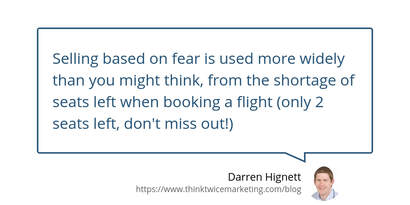 Enjoy a happy retirement by investing in a pension now Don’t lose out on a happy retirement with limited money to live on, invest in a pension now Protect your PC from viruses with antivirus software Avoid losing data and precious time recovering your PC with antivirus software Beat the queues with fast-pass Make sure you don’t waste hours queuing up. Grab your fast-pass now There are benefits to using both styles and a mixture of both is usually the best option. Selling based on fear is used more widely than you might think, from the shortage of seats left when booking a flight (only 2 seats left, don’t miss out!) to pensions, investments and car breakdown cover (don’t get stranded on your own with your car broken down…) to the range of every day offers you see telling you that if you don’t take advantage of the offer in the next 2 hours then you will miss out. In fact, there has even become a widely used term we now use to describe one of our biggest fears - FOMO (fear of missing out). The next time you work on your marketing, consider how you can develop your messaging and the benefits by pointing out both what’s great about what you offer AND what your potential customer could be missing out on. If you would like to learn more about how to promote your products and services based on the way the human mind works then why not grab a copy of my very affordable book Psychology in Marketing and Sales - but be quick, it’s so good I might have to put the price up soon! 😃 Want a recap? The video below is a summary of this blog post. Don't forget to subscribe to our channel on YouTube for more videos! |
written byThe opinions in these blog posts are those of marketing expert and book author Darren Hignett. Categories
All
Archives
October 2022
|
|
Open 9 am - 5 pm
Tel: 07769 331 247 |

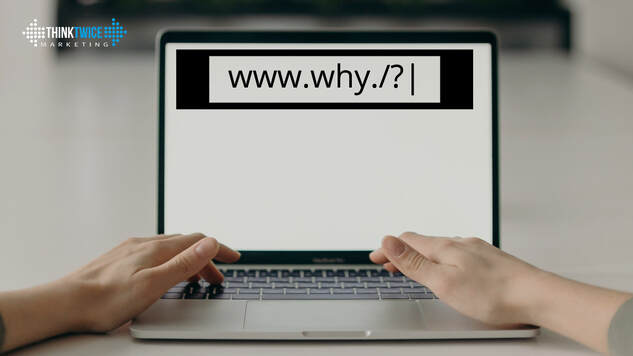



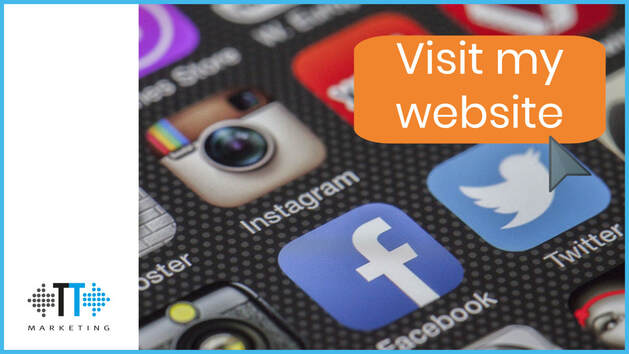
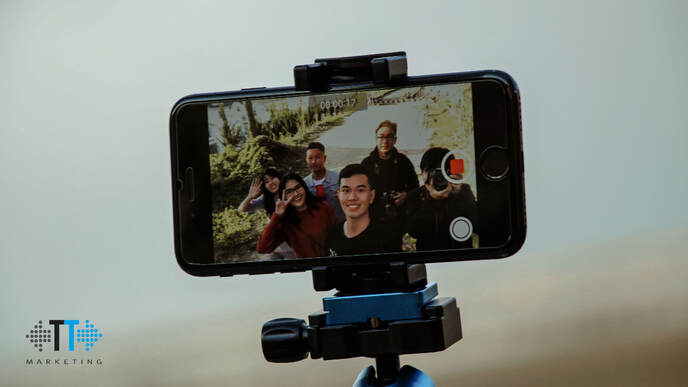


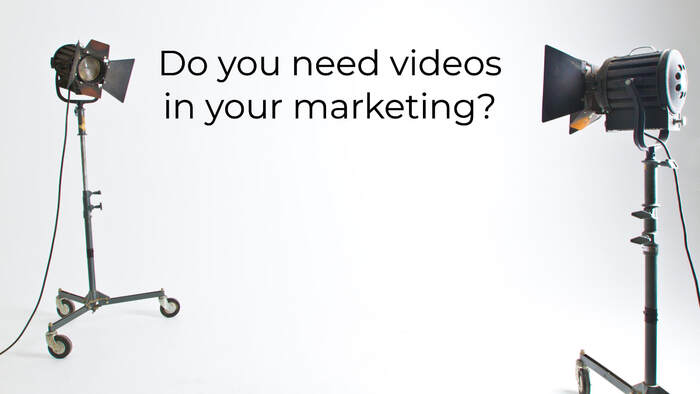

 RSS Feed
RSS Feed